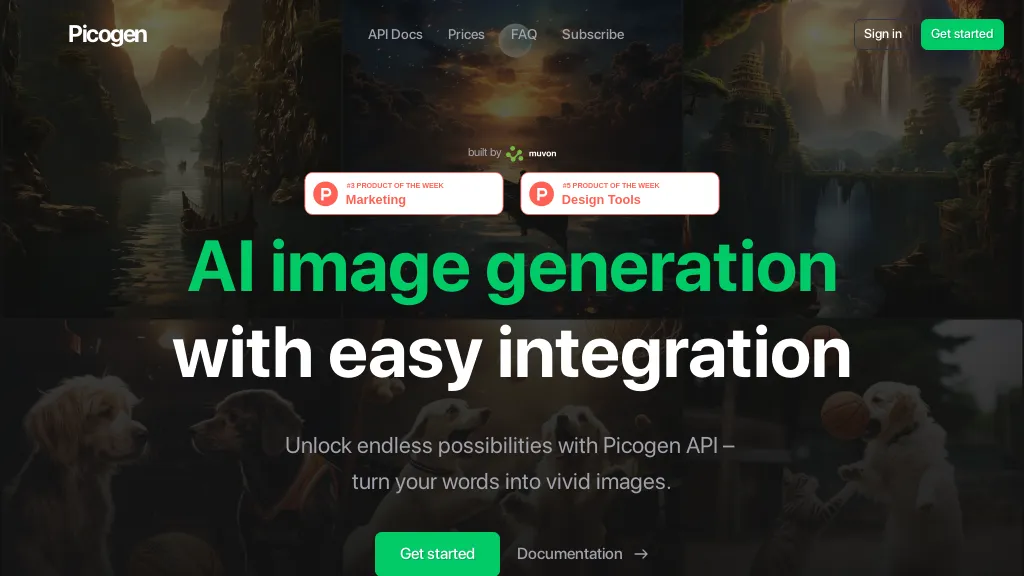What is Picogen?
Picogen is an ultramodern API for envisaging images using AI that has been crafted for perfect integration using REST. Its core purpose is translation—convert any text into eye-catching images to uplift various projects. Armed with the most updated models like Stable Diffusion, DALL-E 2, and Midjourney, Picogen ensures amazing output. With its slick user interface, any user can create images within no time, making the promotional materials, articles, and marketing campaigns top of the chart with luxurious images.
Key Benefits & Features of Picogen
-
Image Generation from Text:
Easily turn text descriptions to exciting images. -
Power Content:
Use for increasing engagement in articles, websites, and landing pages with stunning images. -
Unlock Potential with Midjourney:
The latest features and tips to generate images to their full potential. -
Backed with stable diffusion, DALL-E 2, Midjourney:
leverage power from leading AI models with the best in class image creation. -
Intuitive and Sleek UI:
The whole process of creating new images is simplified, making it user-friendly.
Added to these features, Picogen becomes a brilliant choice to integrate with projects that also require automated and top-level image creation.
Use Cases and Applications of Picogen
Picogen is usable in the below general usability sections:
-
Marketing promotions:
a powerful automation of the material visualization section. -
Automatically generate images for articles and content:
Make written content more visually engaging in an instant. -
Add AI-generated image capabilities to your own app or project:
Easily integrate AI-generated images into your software or web application.
Picogen is particularly useful for rapid and convenient generation of high-quality visuals for experts in marketing, designers, and copywriters.
Ease of Use of Picogen
Getting started with Picogen is very simple:
- Sign up for an account on the Picogen back.
- Access API documentation and get your API key.
- Copy the code snippet provided and add it into your project.
- Change the text input to get different images.
- Publish and manage the image creation process with the intuitive interface.
For best results, use the ultimate prompt crafting handbook that provides you with all professional tips and tricks on how to use Midjourney.
How Picogen Works
Picogen employs as base technologies for image generation from textual input advanced AI models, namely stable diffusion, DALL·E 2, and Midjourney. Complex algorithms and neural networks are employed at these hitech coasts to decode textual descriptions and reiterate them into high-quality visual illustrations. This intuitive interface allows for ease of typing of text, after which generated images can be availed. This workflow ensures that users can quickly and efficiently produce the visuals they need for their projects.
Pros and Cons of Picogen
Pros
- High-quality generated images with the leading AI models.
- User-friendly interface for easy operation.
- Large number of applications in different industries and scenarios.
- Convenient integration with existing projects by using the REST API.
Cons
- An adequate level of technical knowledge might be needed for integration with APIs.
- Some limitations due to dependence on AI modules in very specific needs.
In general, according to user experience, Picogen is a useful application in the automated creation of high-quality visuals, with some limitations.
Picogen FAQ
Picogen is an image generation API. Advanced models are used to turn texts into high-quality pictures, with the latest such as Stable Diffusion, DALL-⅃ 2, and Midjourney.
How do I integrate Picogen with my project?
Join using your email, pick up the API key, and use the provided code snippet to integrate Picogen with your project.
Which industries can apply Picogen to their advantage?
Industries like marketing and graphic design may greatly benefit from this automated image creation by using Picogen.
Are there any cons to using Picogen?
The quality of image generation from Picogen is very high, but it may be somewhat technical when subjected to API integration, and there can be limitations based on wide specificity in customization needs.










